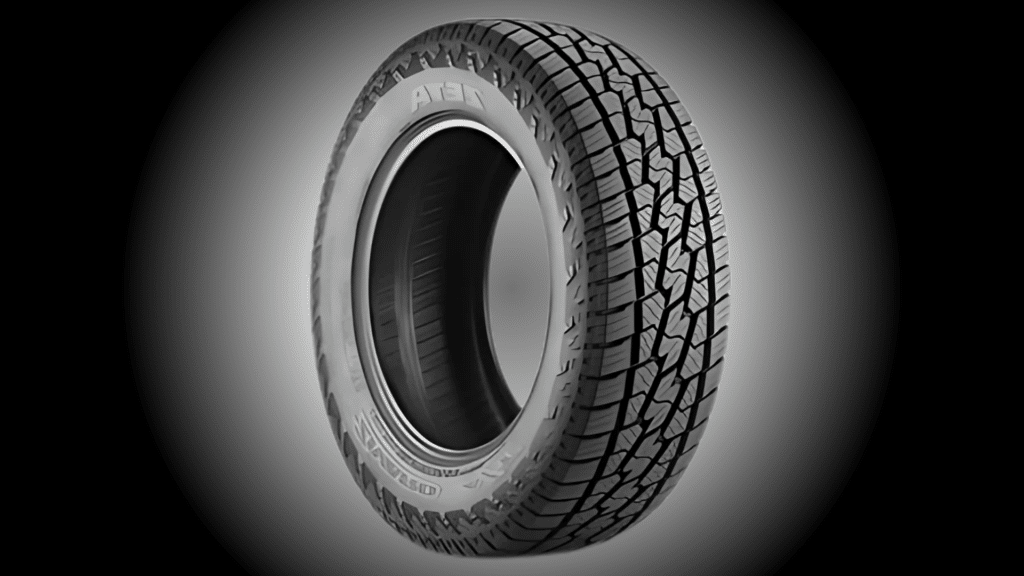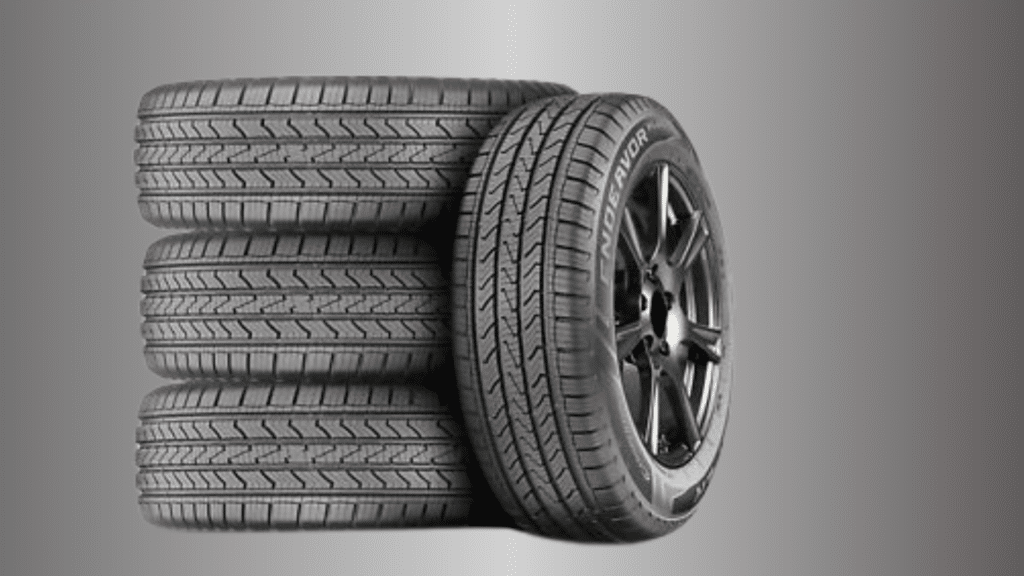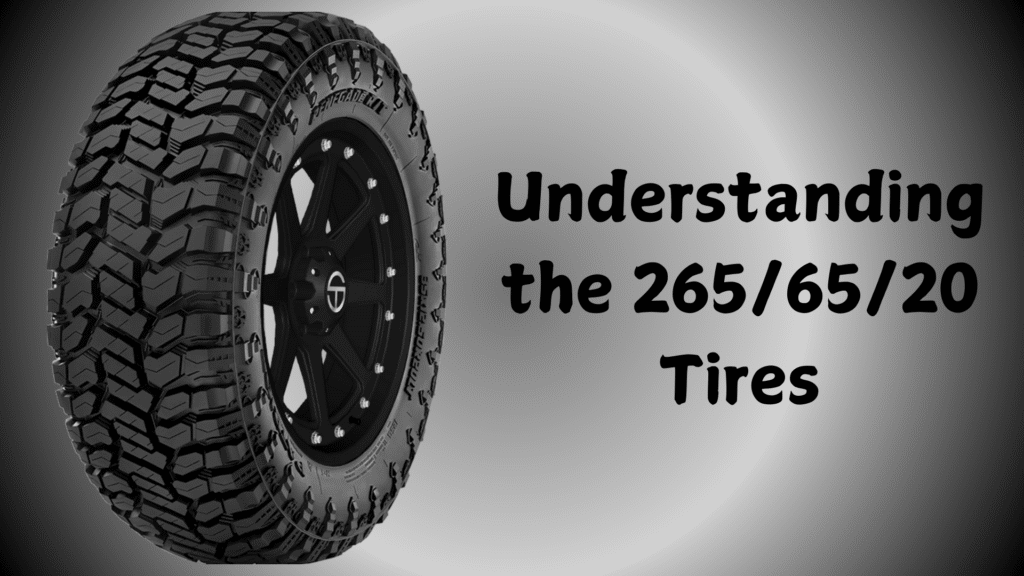265/65/20 tires are a specific tire size designed for SUVs, trucks, and other larger vehicles.
This size represents a combination of width, aspect ratio, and wheel diameter that defines the tire’s dimensions and performance capabilities.
Breakdown of What Each Part of The Size Means

1. Width: 265 mm
- The “265” refers to the tire’s width in millimeters, measured from sidewall to sidewall.
- A width of 265 mm provides a balance between stability, grip, and fuel efficiency, making it suitable for both highway and off-road driving.
2. Aspect Ratio: 65
- The “65” represents the aspect ratio of the tire, which is the height of the tire’s sidewall as a percentage of its width.
- In this case, the sidewall height is 65% of the 265 mm width, resulting in a relatively tall sidewall that helps improve ride comfort and off-road performance.
3. Rim Diameter: 20 Inches
- The “20” indicates the diameter of the wheel (rim) that the tire is designed to fit, measured in inches.
- Tires with a 20-inch rim diameter are commonly used on larger vehicles like SUVs and pickup trucks, offering an appealing blend of style and functionality.
Popular Vehicles That Use 265/65/20 Tires
SUVs and Pickup Trucks Compatible with 265/65/20 Tires
| Vehicle Category | Model | Years | Trim Levels |
|---|---|---|---|
| Full-Size SUVs | Chevrolet Tahoe | 2015-2024 | LT, RST, Z71 |
| Ford Expedition | 2018-2024 | XLT, Limited | |
| GMC Yukon | 2015-2024 | SLT, AT4 | |
| Toyota Sequoia | 2018-2024 | SR5, Limited, Platinum | |
| Pickup Trucks | Ford F-150 | 2015-2024 | XLT, Lariat, King Ranch |
| Chevrolet Silverado 1500 | 2019-2024 | LT Trail Boss, RST | |
| RAM 1500 | 2019-2024 | Rebel, Limited | |
| Toyota Tundra | 2018-2024 | SR5, Limited, TRD Pro | |
| Mid-Size SUVs | Jeep Grand Cherokee | 2021-2024 | Limited, Trailhawk |
| Dodge Durango | 2018-2024 | R/T, SRT | |
| Nissan Pathfinder | 2022-2024 | Platinum, Rock Creek |
Important Notes:
- Tire compatibility may vary based on specific trim levels and optional packages
- Some vehicles may require slight modifications to accommodate these tires
- Always verify fitment with your vehicle’s manufacturer specifications
- Consider load requirements specific to your vehicle’s configuration
Best Brands Offering 265/65/20 Tires
Overview of Leading Tire Manufacturers
These established manufacturers have consistently delivered quality 265/65/20 tires:
| Brand | Known For | Quality Level | Years in Market |
|---|---|---|---|
| Michelin | Premium highway tires, long tread life | Premium | 130+ years |
| BFGoodrich | All-terrain performance, durability | High | 150+ years |
| Goodyear | All-weather reliability, innovation | Premium | 125+ years |
| Bridgestone | Advanced technology, stability | Premium | 90+ years |
| Continental | German engineering, wet performance | Premium | 150+ years |
| Toyo | Off-road capability, value | Mid-High | 75+ years |
Top Picks for Different Terrains
All-Terrain Options
- BFGoodrich All-Terrain T/A KO2 ($220-260)
- 50,000-mile warranty
- Superior rock and gravel performance
- 3-ply sidewall construction
- Goodyear Wrangler AT/S ($200-240)
- 60,000-mile warranty
- Balanced on/off-road performance
- Enhanced wet traction
Mud-Terrain Options
- Toyo Open Country M/T ($240-280)
- Aggressive tread pattern
- Hook-shaped tread blocks
- Excellent self-cleaning
- BFGoodrich Mud-Terrain T/A KM3 ($260-300)
- Mud-Phobic bars
- Linear flex zones
- Enhanced climbing ability
Highway Tires
- Michelin Defender LTX M/S ($230-270)
- 70,000-mile warranty
- EverTread compound
- Best-in-class longevity
- Continental CrossContact LX25 ($210-250)
- 70,000-mile warranty
- EcoPlus Technology
- Superior wet braking
Price Ranges by Category
| Tire Category | Budget Range | Mid-Range | Premium |
|---|---|---|---|
| Highway | $150-180 | $180-230 | $230-300 |
| All-Terrain | $170-200 | $200-250 | $250-320 |
| Mud-Terrain | $190-220 | $220-270 | $270-350 |
Price Factors:
- Seasonal demand
- Raw material costs
- Regional availability
- Installation charges ($20-40 per tire)
- Additional warranties
- TPMS sensor compatibility
Features to Look for in 265/65/20 Tires

Tread Patterns for All-Terrain vs. Highway Use
Tread patterns serve specific functional purposes in tire performance. Highway tires incorporate longitudinal grooves and siping patterns designed to maximize water evacuation and maintain consistent road contact.
The continuous rib design promotes even wear and reduces rolling resistance, enabling optimal fuel efficiency.
All-terrain patterns feature aggressive lugs with variable spacing, typically 12-15mm deep, engineered to provide multi-directional traction.
The void ratio between tread blocks ranges from 25-35%, allowing for self-cleaning capabilities in mud and loose surfaces while maintaining reasonable on-road performance.
Load Index and Speed Rating
The load index for 265/65/20 tires requires careful consideration of vehicle specifications. A load index of 112 translates to 2,469 pounds per tire (9,876 pounds total capacity), while 117 provides 2,833 pounds per tire (11,332 pounds total).
Speed ratings correlate directly with tire construction – H-rated tires incorporate reinforced internal structures to maintain stability at sustained speeds up to 130 mph.
T-rated options (118 mph) utilize different compound formulations optimized for durability rather than high-speed performance.
Durability and Resistance to Wear and Tear
Structural integrity in 265/65/20 tires depends on multiple engineering factors. Multi-ply sidewall construction with nylon reinforcement provides puncture resistance and load stability.
Advanced silica-enhanced compounds deliver both wet grip and longevity through improved molecular bonding.
The UTQG ratings provide standardized comparisons – a 500 treadwear rating indicates 5 times the longevity of the control tire.
Look for tires with cut-and-chip resistant compounds featuring hardness ratings between 60-65 Shore A for optimal durability in varied conditions.
Steel belt packages with optimized angles (typically 25-28 degrees) enhance both handling response and impact resist
Conclusion
Understanding 265/65/20 tires is essential for optimal vehicle performance and safety. These tires offer a balanced combination of load capacity, handling, and versatility across diverse driving conditions.
The size specification ensures compatibility with many modern SUVs and trucks while providing adequate sidewall height for comfort and protection.
When purchasing, focus on three critical factors: vehicle specifications, driving conditions, and maintenance requirements.
Select tires with appropriate load ratings for your vehicle’s weight, and consider your typical driving environment when choosing between highway, all-terrain, or mud-terrain options.
Regular maintenance, including proper inflation (typically 35-40 PSI), rotation every 5,000-7,000 miles, and alignment checks, will maximize tire life and performance.
Frequently Asked Questions
How Do I Know if 265/65/20 Tires Will Fit My Vehicle?
Check your vehicle’s door jamb sticker or owner’s manual for the recommended tire size. These tires typically fit full-size SUVs and trucks, but you’ll need to verify clearance for steering components and wheel wells.
Consider both the diameter and width to ensure proper fitment without rubbing or interference.
What Is the Actual Height of a 265/65/20 Tire?
The total diameter of a 265/65/20 tire is approximately 34.1 inches (866mm). This calculation combines the 20-inch wheel diameter with the tire’s sidewall height, which is 65% of the 265mm width.
This overall height is crucial for speedometer accuracy and vehicle clearance.
How Long Should 265/65/20 Tires Last?
Premium highway tires in this size typically last 60,000-70,000 miles under normal conditions. All-terrain variants usually offer 50,000-60,000 miles, while mud-terrain options average 40,000-50,000 miles.
Actual longevity depends on driving habits, road conditions, and maintenance practices.
What Is the Correct Tire Pressure for 265/65/20 Tires?
Most vehicles using these tires require 35-40 PSI for optimal performance. However, the correct pressure depends on your vehicle’s weight and intended use.
Check your vehicle’s placard (usually found in the driver’s door jamb) for the manufacturer’s recommended pressure specifications.
What Makes Some 265/65/20 Tires More Expensive Than Others?
Price variations reflect differences in manufacturing technology, materials quality, and warranty coverage. Premium tires often incorporate advanced rubber compounds, sophisticated tread designs, and reinforced construction methods.
These features typically result in better performance, longer tread life, and enhanced durability.


